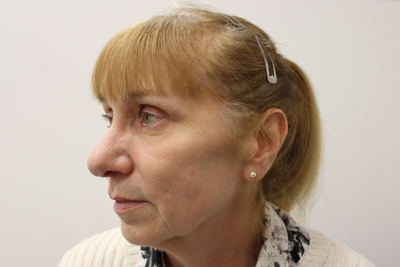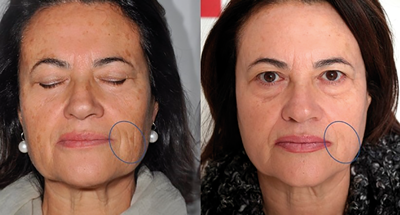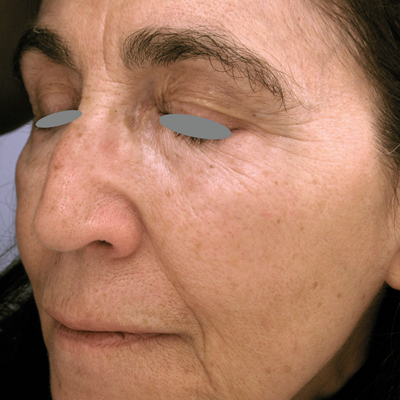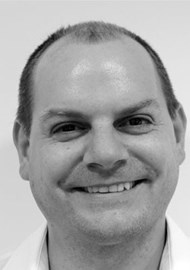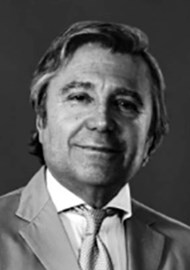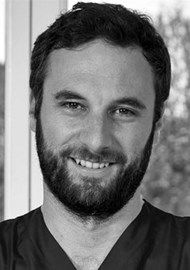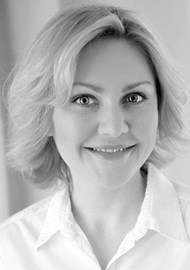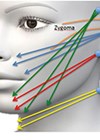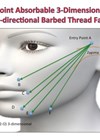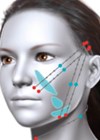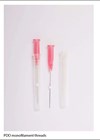PDO threads
By Martyn King
Polydioxanone or poly-p-dioxanone (PDO, PDS) is a colourless, crystalline, biodegradable polymer of multiple repeating ether-ester units and has been used in many disciplines of surgery as subcutaneous and cutaneous stitches for over 30 years. It has many advantages as a suture material due to its very high tensile strength, excellent pliability, low resistance through the skin and it produces mechanical induced skin tension and a stimulation of fibroblasts resulting in natural neocollagenesis. PDO threads have a very high safety profile, complete absorption and minimal tissue reaction making them ideal to be used in the aesthetic market.
There are many PDO threads on the market, many originating from Korea, and include monos, basics, spirals, screws, barbs, hooks, anchors, cogs, 3D and 4D threads which come in a variety of lengths and gauges and can be injected by needle or cannula (blunt or sharp).
Due to their safety and mechanism of action, PDO threads can be used in virtually any patient and almost anywhere on the face or body for lifting, skin rejuvenation and lipolysis. The most common indication in my own practice is for lifting the jowls and the ideal patient is a female in their forties with mild to moderate ptosis of the tissue. PDO threads are also ideal to be used in combination with other treatments including fillers, botulinums, platelet rich plasma and non-cross linked hyaluronic acids.
“The most common indication in my own practice is for lifting the jowls and the ideal patient is a female in their forties with mild to moderate ptosis of the tissue.”
The procedure
Prior to treatment, make-up should be removed, the skin appropriately disinfected and the patient should be assessed in the upright position. Marking out should be done to identify bony landmarks and important structures as well as the areas for thread insertion. Gentle traction on the skin along the vector of the intended thread insertion will give the patient and practitioner a visual idea of what will be achieved with treatment. The patient is then placed in the semi-recumbent position, a mop cap is worn, and drapes used to create a working area.
In the treatment of jowls, my preference is to use between 3 and 5, 20G 90mm blunt cannula with a 2-0 gauge barbed suture each side. Two percent xylocaine with adrenaline is injected in a small bleb at the insertion site and then an entry hole is made with an 18G needle. Prior to insertion of the threads, the cheek area is infiltrated with 1.5-2.5ml 2% lidocaine each side administered via cannula along the intended thread insertion side. The PDO threads are inserted into the deep dermal / subdermal tissue at an initial angle of about 30 degrees. The cannulas should glide through the skin with little resistance if they lie within the right tissue plane. Once fully inserted, the cannula should be pushed a little further whilst pushing the skin upwards against the tip of the cannula to give some extra reach. The hub of the cannula is then rotated through 360 degrees and slowly removed whilst ‘walking it out’ with the other hand so that the suture is left within the tissue. The remaining barbs are then inserted along the pre-determined positions. Once all threads are in position, the skin markings are cleaned off the skin so that the area is not disturbed once the threads are tightened and a small amount of balm applied to reduce friction when tightening. The ends of the sutures are then fastened using a pair of sterile forceps and traction applied in the same vector as the threads whilst pushing the skin upwards along the same vector. It is normal to feel some ‘popping’ as the skin is lifted and this procedure should be repeated until the end result is achieved. It is normal to have about an additional 1cm of suture now outside of the skin, representing the shortened distance within the skin due to the lifting effect. The forceps are now lifted perpendicular to the skin and the sutures can be trimmed down, to avoid sutures protruding from the skin or aggravating the skin surface, it is essential to provide enough traction with the forceps whilst pushing the skin down with a pair of sterile, curved iris stitch scissors so that the ends of the sutures retract beneath the skin surface.
The procedure is completed by the insertion of 5-10 monos (40mm or 50mm) each side perpendicular to the barb threads. This serves to increase collagenesis and provide further support for the lifting threads.
Before.
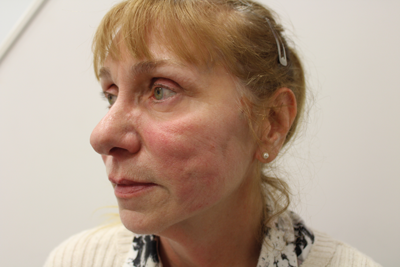
After.
Post-procedure
Following treatment, the patient should be advised to expect some minor swelling, redness and tenderness which should settle quickly. It is not uncommon for bruising to occur and rarely this can be pronounced and there is a small risk of haematoma, particularly if long needles are used. The risk of infection is minimised by correct patient selection and good medical technique and although I have not had any cases in my own practice, I have certainly been involved in the management of some quite severe infections following PDO threads. Occasionally the threads may work themselves out and be felt at the surface of the skin, these should be pulled out, trimmed or buried when identified to prevent infection risk.
Patients should be instructed to not massage, disturb the area or have any physical facial treatments for three weeks following treatment. Patients should keep certain facial movements to a minimum and avoid direct pressure or sleeping on the face.
Absorption is dependent on suture thickness and placement but mostly completed by six to nine months, however due to the formation of new collagen within the skin, results can last for one to two years. There will be some immediate lifting and repositioning and further improvements can be expected over the next few weeks as neocollagenesis takes effect.
Top Tips
-
Insert the barbs first, then screws and the monos at the end (or equivalent).
-
Use the longest thread possible for each area to get the best results (even if some of the thread needs to be trimmed).
-
If treating several areas, divide them into zones and start from the top and work down. Complete one zone at a time.
-
Do not leave the threads protruding out of the skin for too long.
-
Ensure that when trimming the threads, tension is applied, and they are cut beneath the level of the skin.
-
If a barb is being inserted too superficially, create an exit opening distally and push the tip of the needle / cannula through it so the PDO thread can be pulled out (if you try and pull it out backwards, it is likely to get stuck).
Declaration of competing interests:
Dr King is a KOL and PDO trainer for Schuco, Medical Aesthetic Group and First Lift.
CO2 lasers for facial skin tightening
By Paolo Bonan and Nicola Bruscino
Patients often show a particular interest in minimally invasive treatments for facial skin tightening. These are especially able to improve the periorbital area, since it is where the first and most visible manifestations of ageing appear. Knowledge of the patient’s anatomical features is crucial; I often observe a combination of photodamage with dyschromia and wrinkles, volume loss, and hypertrophy of the underlying muscles.
A variety of dermatologic approaches are available for facial skin tightening and rejuvenation, such as topical therapy, chemical peels, dermoabrasion, botulinum toxin injection, filler injection, radiofrequency and laser resurfacing, all with the relative benefits and risks. Fractional CO2 lasers can now be equipped with a new scanning system (HiScanDOT/RF); it makes it possible to obtain vertical micro-columns of damage, micro-ablative and micro-thermal zones (MAZs and MTZs), surrounded by areas of untouched skin, which induce a fast healing and re-epithelisation. Depending on the pulse used, the controlled release of heat in the treated micro-areas has an immediate tissue-shrinking effect and generates the stimulation of growth factors, wound repair, and the reorganisation of new collagen.
“Faster healing allows patients to return to a normal life in public within the first week after the laser session, since there are no marked side-effects to hide or tolerate.”
The versatility of this device also derives from the ‘Smart Pulse mode’, a function that allows me to obtain two different effects in the target area to be treated, depending on the patient’s needs and the type of treatment required, namely, ‘the ablative effect’ and the ‘thermal effect’. The first, which depends mainly on the power (Watts), is achieved with a fast release of high energy to the tissue causing rapid ablation of the epidermis and more superficial dermal layers. Instead, the ‘thermal effect’ depends mainly on the dwell time (µs) during which the heating of the deeper layers of the skin spreads to the surrounding areas and deeper areas of the MTZ, continuing the laser effect. Another important function that we use is the novel ‘Pulse Stacking mode’. Each treatment session consists of numerous successive and consecutive pulses (one to five) in the same point without moving the scanner (‘scalpel effect’).
The new laser systems simultaneously deliver laser and bipolar radiofrequency; the latter is able to amplify and enhance the effects of the CO2 laser by remodelling the tissue in-depth, toning flabbiness and stimulating fibroblast activity to produce new collagen. The resulting inflammatory cascade contributes to an additional skin tightening effect. The laser-radiofrequency combination minimises the amount of energy required from each system to achieve the desired results, decreasing the possibilities of side-effects. Faster healing allows patients to return to a normal life in public within the first week after the laser session, since there are no marked side-effects to hide or tolerate.
Figure 1: After only two fractional CO2 laser treatments the patient showed a marked
improvement of her wrinkles and hyperchromias, as the blue circle highlights.
The procedure
A detailed personal history (skin type, clinical manifestations, health conditions, previous medications and lifestyle) and an informed consent for treatment are always requested from patients. After removing make-up, an anaesthetic cream is applied 20 minutes before the session to achieve more positive patient compliance; we prefer the application of an eutectic mixture of lidocaine 2.5% and prilocaine 2.5% in an oil in-water emulsion, which is removed immediately before beginning the treatment. The patients usually receive from three to five treatments at four to six weekly intervals using the SmartXide2 DOT/RF laser device (DEKA-M.E.L.A., Calenzano, Italy). Each treatment session entails one pass only per area with numerous successive and consecutive pulses in the same point (DOT) without moving the scanner (‘scalpel effect’) and using the ‘Pulse Stacking’ function. The settings include 8-15W, 500-750µm DOT spacing, 500–1200µs dwell time, up to two stacking. The therapeutic sessions entail the combined effects of radiofrequency and laser applied simultaneously. The bipolar radiofrequency settings are 20-30W, 23s.
Post-procedure
At the end of the treatment, compression is maintained for approximately 20 minutes with gauze soaked in saline solution, followed by the application of a moisturising cream. Patients are instructed to avoid the sun and cosmetics during the immediate postprocedural periods and to apply cool compresses, emollient creams and sunscreens until complete re-epithelisation. An antibiotic ointment and an antiherpetic cream are also applied to the target areas from two days before treatment up to seven days after each laser session, as herpetic and bacterial complications are possible in the absence of appropriate pre- and post-treatment care. Evaluation photographs are taken before and after each treatment and at the four-week, three-month and six-month follow-ups after the final treatment.
Declaration of competing interests: None declared.
Er:YAG and Nd:YAG lasers for skin tightening
By Vesna Tlaker
Loss of collagen leads to poor skin quality and sagging. It is a universal problem of ageing, and no treatment plan is complete before the issue of collagen stimulation and skin tightening is properly addressed. Stimulation of natural processes that boost the body’s own mechanisms of collagen production yields the most beneficial results. This article will explain my preferred treatment option for patients who opt for natural results with no downtime, regardless of whether or not they also choose to do other treatments like injectables.
Fotona4D® is a novel, non-invasive laser face-lifting treatment of both the exterior facial and interior oral cavity. The procedure provides full-thickness contraction of collagen for persistent tightening and volumisation without injectables. Combining the power of two laser wavelengths (Er:YAG and Nd:YAG) and four treatment modes, the skin is comprehensively approached at four different levels, working on deeper, mid-depth and superficial connective structures of the skin, as well as targeting imperfections. Fotona4D® is extremely popular among patients because it is a fast procedure with little or no downtime, and treatment can be performed year-round.
Since the 2940 nm Er:YAG wavelength is highly absorbed in water – the main target chromophore for skin resurfacing, it is effective in brushing away surface imperfections with precise, micron layer-by-layer ablation. The advantage of the Er:YAG laser is that through regulation of pulse duration, the amount of heat generated during the treatment can be controlled. Therefore, we can choose from cold laser ablation with very short pulses and almost no heat to hot ablation with long pulses, similar to a CO2 peel. Moreover, by further extending the pulse length, there is no ablation but only heating of the tissue. Having this characteristic in mind, Fotona has developed a revolutionary non-ablative Er:YAG pulse technology called Smooth mode. Because of its precise and safe control of thermal deposition, Smooth mode is ideal for non-invasive thermal collagen stimulation.
The Nd:YAG laser wavelength complements the Er:YAG wavelength by penetrating deeply into the skin to create thermal effects without damaging the skin surface. Its homogeneous absorption in skin and low absorption in melanin allow it to be safely used with all skin types. The Nd:YAG wavelength is, therefore, effective in reaching the deepest layers of the skin.
The full procedure for the face takes 30-45 minutes and can be done as a lunchtime treatment by staff that have been properly trained. The discomfort is minimal and no pain management is needed.
The four ‘dimensions’ of Fotona4D® refer to four distinct treatment modalities: SmoothLiftinTM, FRAC3®, PIANO® and SupErficialTM.
Before.
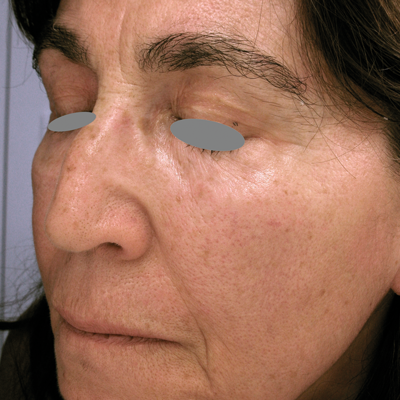
After one treatment.
The procedure
In the first step, a non-ablative Er:YAG laser is used for controlled intraoral, gentle bulk-heating treatment. This stimulates collagen contraction and production in the perioral and buccal regions. Over the long-term, this step contributes to reducing nasolabial folds and wrinkles around the mouth. Next, the whole face is treated utilising the Nd:YAG laser’s non-ablative modality. This complements the effect of the intraoral treatment by creating a self-induced, 3D fractional effect that targets specific deeper imperfections and restores a more youthful skin texture. In the third step, we use an ultra-long Nd:YAG pulse modality, which provides deep bulk tissue heating and tightening safely and rapidly from the outside in, by concentrating energy delivery subcutaneously.
With the Nd:YAG ultra-long mode, we perform a brushing technique to complete the full-thickness heating for an overall synergistic tightening effect. In this essential step, precise monitoring of the temperature is enabled through a thermal camera that is built inside the handpiece. The target temperature can be set, and a flashing light on the handpiece gives us real-time feedback on whether we are within, below or above the target temperature range.
In the final step, a mild superficial peel is performed using a light cold Er:YAG laser procedure. This gives a pearl finish to the skin to additionally improve the skin surface and provide a nice glow. With this final step, patients can expect one to two days of mild redness; therefore, if the patient does not want any downtime, Step 4 can be avoided. The treatment can be complemented with appropriate skincare products, and sun protection is advised. Immediately after the treatment, patients love the feeling of tighter and refreshed skin. For optimal results several treatments at monthly intervals are recommended. Over the longer term, the treatment improves skin quality and provides natural results that can be combined with other aesthetic treatments.
Declaration of competing interests: None declared.
COMMENTS ARE WELCOME

